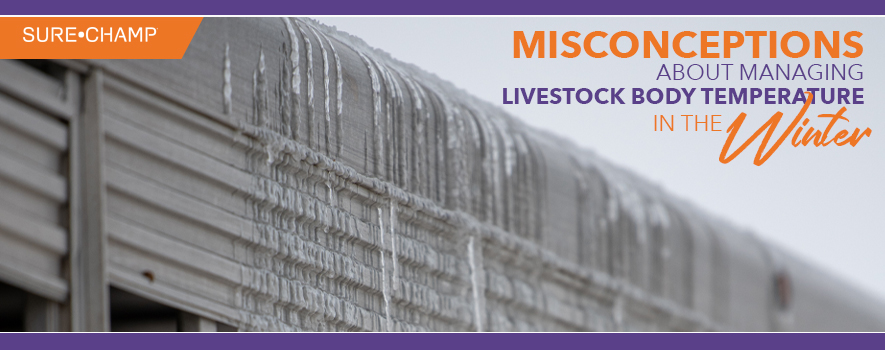
Humans tend to worry about the weather and the outside temperature. And rightfully so, especially if you are involved in agriculture. Your crop planting, growing and harvest times rely heavily on the weather. And, when you have livestock, you want to keep them safe from the elements and provide them as much comfort as you possibly can. Show livestock are no different. They are well-cared for, but in the winter, when most humans are layering up to stay warm, show livestock can actually experience heat stress.
Temperature is not the only measurement associated with heat stress, so show livestock tend to express signs of heat stress more often than livestock in their natural habitat. Heat stress is related to ambient temperature along with humidity and air movement. When the humidity increases the animal’s evapo-transpiration is reduced, and it cannot cool itself. This inability to cool itself increases the core body temperature. Let’s look at three common misconceptions about managing your show animals’ body temps during the winter.
1. If I’m cold, my livestock must be cold.
No. Even though you’re cold, your animals are actually probably quite comfortable, or even hot. One of the primary causes of heat stress in the winter is the digestive system working overtime to break down the feed. Exhibitors often feed a higher-energy diet to meet nutrient requirements in the colder months. Therefore, the rumen works extra hard to break down the feed, creating extra internal heat in the animal.
“When we lead these haired-up show cattle in to a hot, humid barn with little air movement from the cool tie-outs, their body temperatures increase significantly,” said Blaine Rodgers, Show Livestock Business Development & Field Support for BioZyme® Inc. “Livestock start to experience heat stress at 70-degrees, and we know from personal experiences those barns can be hotter than 70. We also need to remember that their rumen is working extra hard to break down their feed, raising their internal temperature even more.”
Besides digestion and extreme Temperature Heat Indexes (THI) created in hot, humid barns, other causes of heat stress at winter shows include extreme temperature shifts when traveling between climates and altitudes and walking long distances from tie-outs into a hot barn.
2. Since it isn’t so hot outside, my animals don’t need as much water.
It doesn’t matter the season or the temperature, water is always the most vital nutrient to your animals’ health. Heat stress can wreak havoc on your show animals’ overall health, causing challenges with their digestive, respiratory, immune and reproductive systems. Livestock will go off feed and water when they are stressed, they start to breath heavily, which can lead to respiratory issues. As well, their immune system is compromised which could result in additional health challenges.
“Keeping animals comfortable in the winter is a challenge, especially when we have temperature fluctuations like we have recently or when we take them from outside into a heated barn,” Rodgers said. “Seventy degrees this time of year feels a lot hotter to your animals than it does in June or July, so we definitely need to keep their body temperature constant, regardless of the outside temperature.”
3. I need to keep my trailer warm while hauling livestock to winter shows.
Traveling to a show in a poorly ventilated trailer can cause unneeded heat stress. Animals create their own body heat, and the more animals that you put in your trailer, the warmer that trailer will be. Don’t forget to keep your trailer properly ventilated while traveling, and even though it seems cold outside, all species need that ventilation as they will generate body heat in an enclosed trailer while going down the road, just like humans put off body heat when they are in an enclosed area.
Heat stress doesn’t need to stress you out. One way to help your show animals defeat heat stress is with products developed by Sure Champ® that help all show livestock species maintain their body temperature in a safe, fast, and natural way using the Amaferm® advantage. Sure Champ Extreme and Vita Charge® Climate Control Gel are two easy-to-use supplements to help your animals stay healthy and support normal body temperature. Sure Champ Extreme is a pelleted, daily supplement designed to be mixed into or top-dressed onto feed. Vita Charge Climate Control is an oral gel that works as a vasodilator that widens the blood vessels, increasing blood flow and thus cooling the body. It is recommended to be given two-three days prior to traveling to the show, and then daily while at the show when in a warmer, more humid climates.
Amaferm, a key ingredient in all Sure Champ and Vita Charge products, is a precision-based prebiotic designed to enhance digestibility by amplifying the nutrient supply within for maximum performance, and it is research-proven to lower body temperature and maintain performance during heat stress. It is also proven to increase water and feed intake while decreasing the body temperature in heat-stressed animals. As Amaferm aids in digestion, that decreases the amount of work the digestive tract has to do, therefore lowering the body temperature caused by digestion.
Other ways to help regulate your animals’ body temperature include putting up fans in the barn, rinsing animals, and making sure they stay hydrated with plenty of fresh, cool water.
Keep your livestock comfortable this winter, even with fluctuating temperatures with the assistance of Sure Champ Extreme and Vita Charge Climate Control Gel. Regulating your livestock’s body temperature keeps them eating, healthy and performing.

